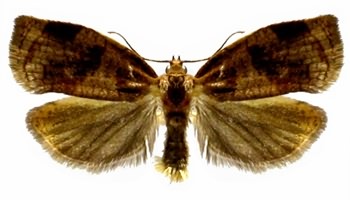Pests
Archips rosana L. - European Leafroller, Rose Tortrix Moth, Currant Leafroller.
Taxonomic position.
Class Insecta, order Lepidoptera, family Tortricidae, subfamily Tortricinae, tribe Archipini, genus Archips.Synonyms.
Cacoecia rosana L., Tortrix laevigana Schiff.Biological group.
It is a polyphagous pest of mainly fruit crops and forest trees.Morphology and biology.
Fore wings of imago (wingspan 15-22 mm) are ochre-yellow to gray brown and dark brown. The anterior margin has weak sub-apical emargination. The apical angle is sharp. Males have distinct dark-brown pattern with rhombic pre-tornal spot, oblique median band; pre-apical and outer marginal spots are merged. Females have a strongly dim and hardly visible pattern. Hind wings are brown-gray; females have a bright orange-yellow pollination at wing apex. Eggs are elongate-oval, gray-green. Caterpillar 18-20 mm long, light green to dark-olive-green, translucent. Pupa (10-12 mm long) is fusiform; yellowish-brown, with darker dorsum. It is usually located between leaves or in leaf cigars rolled along main rib. Average fertility is 250, potentially 430, eggs. Female lays eggs in one layer by groups of 40-100 eggs in a batch, 60 on the average, on smooth bark of the lower part of trunk at a height of 7-27 cm or in forks of skeletal branches. Egg-batch surface is covered with transparent wax-like substance mixed with moth scales. The eggs over-winter. Hatching caterpillars eat together, skeletonizing one of the leaves, then creeping toward shoot tips. Caterpillars of the 1st and 2nd instars eat buds and flower buds, then move on to flowers, destroying stamens, pistils, and petals, and also skeletonizing young leaves. Older caterpillars cause damage to the ovaries and fruits, hollowing out irregular-shaped pits in pulp, sometimes reaching seed chamber or stone. Duration of caterpillar development is 25-60 days. Pupation occurs in feeding places. Depending on the temperature, the pupa stage lasts 8-14 days.Distribution.
Species is distributed throughout Europe, North Africa, Asia Minor, Middle East, Iran, Iraq and North America. In the former USSR it is distributed throughout European part, in Transcaucasia, Middle Asia (foothills), Kazakhstan, Ural, in south Siberia (locally), in the Far East.Ecology.
It is monovoltine everywhere. Moths fly from the end of May until the beginning of August with a peak flying period in the 2nd half of June. Lifespan is 8 to 30 days. Moths are active after sunset. Lay eggs 3-5 days after moth appearance. Mass spreading of eggs occurs in Ukraine from the 2nd half of June to the 1st third of July. Eggs survive frosts to -27°C, but perish in winters without snow. Although apple is favored during caterpillar development, they prefer to lay eggs on bush branches, especially on currant, where optimum microclimate conditions are formed. These conditions include the absence of wind or weak air streams and slow cooling of aboveground spaces in the evening. During mass outbreaks of the Leaf roller on black currant its harmfulness also sharply increases in apple orchards, especially in mixed plantations of apple and currant. Caterpillars begin hatching at degree days 40-57° (above 8°C); mass hatching occurs at degree days above 70°. On currant the caterpillars eat from the middle of May until the middle of July, from the period of budding until just before berries ripen.Economic significance.
Caterpillars are registered on 130 species of plants belonging to 32 botanical families including fruit and berry cultures, deciduous trees and ornamental bushes, dicotyledonous grasses and some cereals. Caterpillars cause maximum harm to rosaceous and saxifragaceous fruit and berry cultures (black currant, apple, apricot, barberry, other stone-fruits, almond, pomegranate, cowberry). During mass outbreaks the caterpillars feed on shoots and saplings of corn, cabbage, lucerne, clover, and finish feeding on wheat, impacting crops of field cultures at a distance of 50 m from arboreal plantations.Control measures.
Agronomic measures include removing old bark in the lower part of trunks, pruning old and diseased branches. Biological measures include the release of Trichogramma in orchards during egg laying, application of biological preparations. Chemical measures include local insecticide treatments during hatching of caterpillars. Monitoring and forecasting are possible with the use of pheromone traps.Reference citations:
Babenko Z.S. 1982. Phytophagous insects of fruit and berry plants in forest zone of Ob River Region. Tomsk: Tomsk University. 268 pp. (in Russian).D.yakonov A.M., Kozhanchikov I.V. 1949. Lepidoptera. In: Pavlovskii E.N., Shtakelberg A.A., eds. Pest Animals of Middle Asia (handbook). Moscow-Leningrad: AN SSSR. 179-198 p. (in Russian).
Ermolaev V.P. 1988. Tortricidae. In: Kirpichnikova V.A., Ler P.A., eds. Butterflies - pests of agriculture in the Far East. Keys. Vladivostok: Biology and Soil Institute, DO AN SSSR. 65-99 p. (in Russian).
Grichanov I.Ya., Bukzeeva O.N., Zakonnikova K.V. 1994. The influence of temperature on the phenology of Archips rozana (Lepidoptera: Tortricidae). Arch. Phytopath., Pflazenschutz, 2: 183-189.
Kostyuk Yu.A. 1974. Family Tortricidae. In: Vasil.ev V.P., ed. Pests of agricultural crops and forest plantations. V. 2. Arthropods. Kiev: Urozhai. 261-320 p. (in Russian).
Kuznetsov V.I. 1994. Family Tortricidae. In: Kuznetsov V.I., ed. Insects and mites - pests of agricultural plants. V. 3(1). Lepidoptera. St. Petersburg: Nauka. 51-234 p. (in Russian).
Kuznetsov V.I. 2001. Family Tortricidae (Olethreutidae). In: Ler P.A., ed. Keys to the insects if the Russian Far East. V. 5(3). Trichoptera and Lepidoptera. Vladivostok: Dal.nauka. 11-472 p. (in Russian).
Markelova E.M. 1963. Ecological features of Cacoecia rosana L. (Lepidoptera, Tortricidae) development in orchards of Moscow Region. Entomologicheskoe obozrenie, 42(4): 733-735. (in Russian).
Markelova V.P. 1957. Exapate congelatella Cl. and Cacoecia rosana L. as pests of berries in Leningrad Region. Entomologicheskoe obozrenie, 36(2): 355-369. (in Russian).
Prokof.ev M.A. 1987. Siberian orchards protection against pests. Moscow: Rossel.khozizdat. 239 p. (in Russian).
Savzdarg E.E. 1954. On mass outbreaks of Rose Tortrix Moth and its control on berry bushes. In: Loza G.M., ed. Referaty dokladov TSKHA, Issue 19. Moscow: TSKHA. 218-223 p. (in Russian).
Savzdarg E.E. 1960. Pests of berry cultures. Moscow: Sel.khozgiz. 270 p. (in Russian).
Vasil.ev V.P., Livshits I.Z. 1984. Pests of fruit crops. Moscow: Kolos. 399 p. (in Russian).


